The OnePlus 3 Review
by Brandon Chester on June 20, 2016 8:00 AM EST- Posted in
- Smartphones
- OnePlus
- OnePlus 3
Display
Update: OnePlus has since addressed the issues with calibration. Click here for my follow-up article.
One of the most disappointing aspects of the OnePlus 2 was its display. Like the OnePlus One it was a 5.5” IPS LCD display, but the similarities ended there. The OnePlus One shipped with a very well calibrated display, and at the time that wasn’t something you could always expect from devices priced around $300. With the OnePlus 2 the display got a much appreciated boost in peak brightness, but the color accuracy regressed severely. The display was heavily blue shifted, and to say that it tied the Nexus 6 as the most inaccurate display tested in recent years would actually be generous. With how good the display on the OnePlus One was, the OnePlus 2 was a huge letdown.
The OnePlus 3 is a chance for OnePlus to fix the mistakes they made with the OnePlus 2. Like the past two OnePlus flagship devices, we’re still talking about a 5.5” display. However, OnePlus has moved to an AMOLED panel. OnePlus calls this an Optic AMOLED display, although they don’t go into much detail on what that means, beyond claiming that the display uses “Custom-engineered gamma corrections that help create a more natural viewing experience”. It’s generally not a good sign when the description of a technology is very vague and just throws in some technical jargon instead of quantifying and explaining what is actually going on. OnePlus also claims that the display “produces colors that are more vivid and true-to-life than other AMOLED displays”, which sounds like good news given how accurate the AMOLED displays on other smartphones already are.
Before covering display accuracy, I want to comment on OnePlus's use of a 1080p AMOLED panel. According to comments made by OnePlus, a 1080p display was chosen as it provides superior battery life, and because resolutions above 1080p are not useful outside of VR. I have to respectfully disagree with both points, especially because this is a PenTile AMOLED display. It has been well demonstrated that good battery life is achievable not just with 1440p AMOLED smartphones, but with 1440p LCD smartphones. While I do feel 1080p is a good resolution to choose for a 5.5" RGB LCD panel, it is simply not adequate for a PenTile AMOLED display.
When you consider the effective resolution of red and blue on the OnePlus 3, you're really dealing with a display that is roughly equivalent to the iPhone 6s in chroma resolution, except on a 5.5" display instead of a 4.7" one. The resolution for green is equivalent to a 1080p display, and subpixel rendering is what allows you to make the claim that it's still a 1080p display, but for everything except pure green your effective resolution is going to be lower. In addition to that, the uneven size and spacing of the subpixels, along with their diamond pattern, makes them less than optimal for rendering the latin alphabet which contains many vertical lines. This kind of screen door effect has long been noticed on PenTile displays, and for the most part the push for 1440p AMOLED panels has mitigated those complaints.
On the OnePlus 3 it's pretty obvious that text is rendered less clearly than the iPhone 6s, which has a pixel density of only 326ppi, well below that of flagship Android devices. With the OnePlus One and OnePlus 2 for comparison it's completely obvious that the OnePlus 3 has a lower effective resolution, with text exhibiting distracting artifacts, and solid patterns that are red, blue, or white having a crosshatch pattern that simply isn't visible on OnePlus's older smartphones. I completely agreed with OnePlus's choice of 1080p on their past smartphones, but saying that there's no benefit to going higher on a PenTile AMOLED display is simply false, and there's no getting around the fact that the OnePlus 3 has a lower effective resolution than its predecessors.
While OnePlus isn't off to a great start with their display resolution, there are many other aspects of a display that need to be considered beyond the number of pixels. To examine the OnePlus 3’s display I’ve run our standard display workflow on it. As always, measurements are performed with an i1Pro 2 spectroradiometer, with the exception of contrast which is done with an i1Display Pro colorimeter. Data is collected and managed with SpectraCal’s CalMAN 5 software.
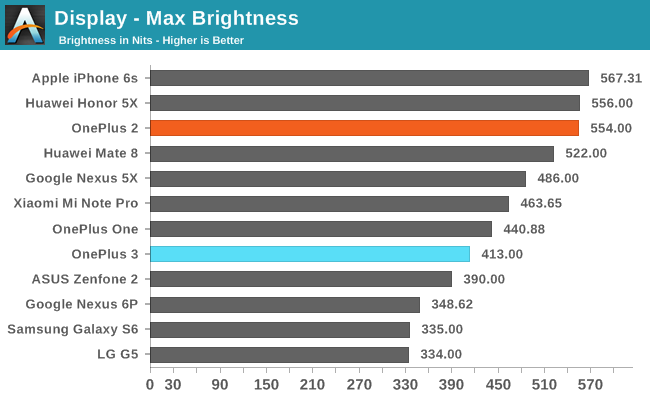
Right out of the gate things are not looking good for the OnePlus 3. Peak brightness only hits 413 nits, which is a huge regression from the OnePlus 2’s 554 nits. The impact that this has on outdoor usability is very significant, with the display being much harder to use in the sun than the OnePlus 2. To make matters worse, there’s no brightness boost mode that activates when you have the auto-brightness on. At this point I really don’t think it’s acceptable to ship a phone that can’t hit 500 nits when you’re in the sun, and Samsung is pushing 600 nits on their AMOLED displays when they boost brightness so OnePlus is well behind the competition.
Given that the OnePlus 3 uses an AMOLED display, you technically have infinite contrast when there’s no ambient light. In practice the OnePlus 3 definitely has better black levels than any LCD device that I own, but the OnePlus 2 still had a great static contrast ratio, and the better blacks weren’t worth sacrificing the 550 nit peak brightness at all.
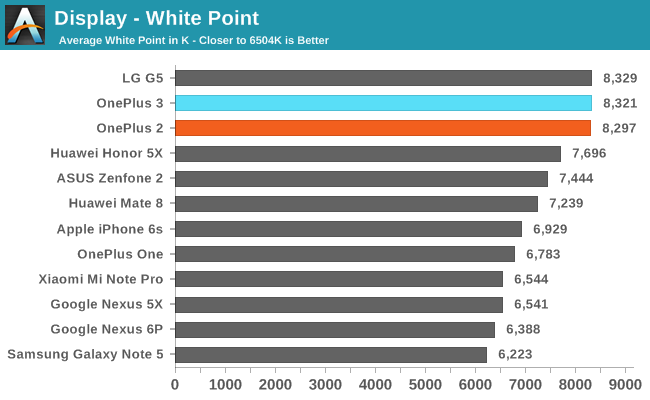
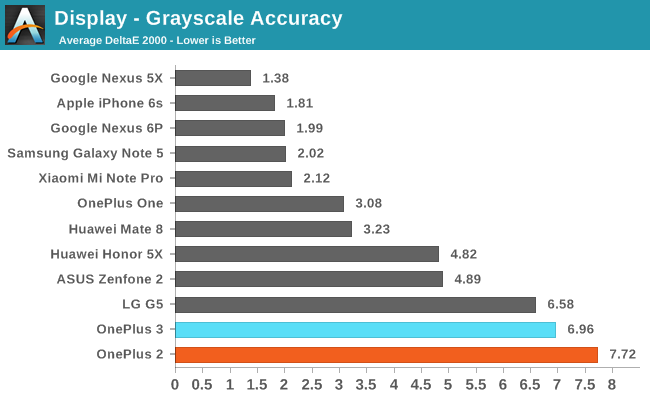
Greyscale accuracy on the OnePlus 3 is very poor. It’s not as bad as the OnePlus 2, but given how severe the errors are, it’s entirely possible that I just happened to get an exceptionally bad OnePlus 2 unit and an exceptionally good OnePlus 3. Whatever the case may be, the OnePlus 3 still has severe issues with greyscale rendition. Gamma is somewhat more accurate than the OnePlus 2 that I received, but the display has even more severe blue shifting, and it’s immediately apparent right from the very first setup screen when you turn on the phone.
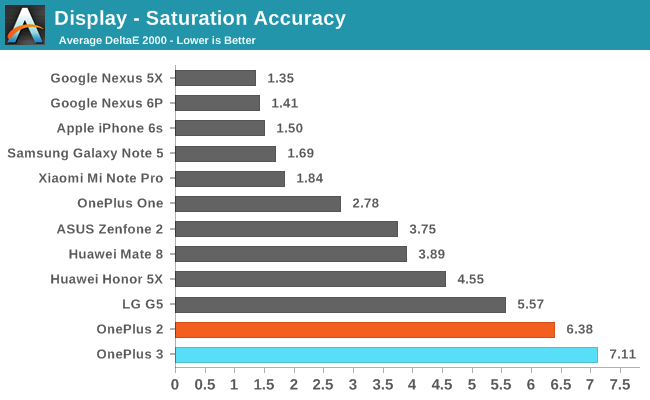
In the saturation sweep test, the OnePlus 3 performs even more poorly than the OnePlus 2. You can tell from the gamut that they’re actually targeting NTSC, which makes me feel like I’ve been sent back in a time machine to 2010 where this was the problem with AMOLED displays on smartphones like the Nexus One and the original Galaxy S. I really thought that we had moved past this, past the point where AMOLED phones would ship with nonsensical gamut targets that you can’t change, but clearly I was wrong.
What I really don’t understand is why the NTSC gamut was chosen as the target. With very old AMOLED phones this was chosen under the mistaken belief that NTSC was the correct gamut to use for displaying videos on smartphones, which was absolutely wrong. The gamut defined in the NTSC standard is over sixty years old, it was never even reproduced properly on the CRT displays of the time because they couldn’t do so with an adequate brightness level, and it was replaced as a “standard” gamut decades ago, basically not ever being used outside the Americas at all. When a smartphone targets Adobe RGB you can at least see the misguided but well-intentioned attempt to give a wider gamut using a color standard that actually is used in some cases, but when NTSC is the target it just shows a severe lack of understanding of modern displays and color standards.
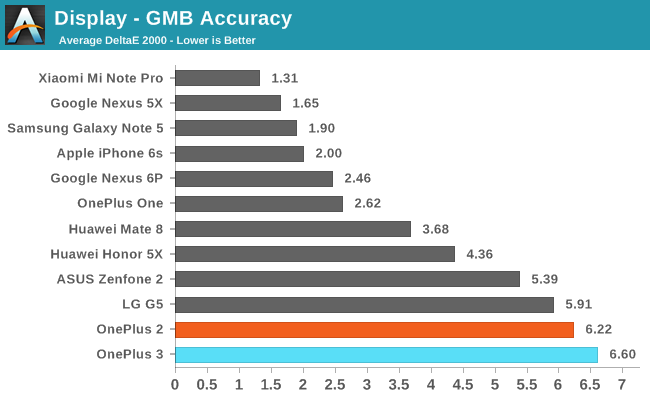
With poor greyscale and color reproduction, there’s absolutely no hope for proper color mixture rendition. As expected, the OnePlus 3 also regresses here, and beats the OnePlus 2 as the most inaccurate display on the chart. I really don’t have anything else to say here, as I’m just so frustrated by OnePlus’s choices here.
It’s evident that OnePlus didn’t learn from the issues I demonstrated with the OnePlus 2’s display. It was a serious regression from the OnePlus One, and with the OnePlus 3 they’ve somehow found a way to regress even further. Of all the aspects of a phone to mess up, the display is the absolute worst. There’s basically no use case where you use a phone without looking at the screen, and right from the very first moment I turned on the OnePlus 3 I could tell that the colors are completely wrong. It’s just a huge disappointment.
There is one glimmer of hope. After reaching out to OnePlus, explaining why the choice of the NTSC color space as a target doesn't make any sense, and showing the errors it causes with sRGB rendition, they told me that they now intend to offer an sRGB mode as an option in an upcoming OTA update. There's no firm timeline for this which makes me uneasy, and I can't make a recommendation based on an update that isn't guaranteed, but it's worth making note of. Unfortunately, I am unsure of whether or not this is something that can be fixed after the phone has already shipped. OnePlus has left the display extremely blue which is often indicative of little or no white point calibration, which would mean it's impossible to tune the phones because you don't even have an idea of what the panel characteristics are. For that reason, I remain hopeful but somewhat skeptical, and I plan to revisit the display of the OnePlus 3 if and when OnePlus adds this feature.
While an sRGB mode may be coming, right now the display accuracy you get on the OnePlus 3 reminds me a great deal of early AMOLED devices from 2010, and that's not a good thing at all. I really expected OnePlus to fix their mistakes from the OnePlus 2 because they did so with so many other aspects of the phone. The only explanation I can think of is that nobody actually understood the negative impact of shipping a wide gamut display on a non-color-managed operating system. This actually seems like the most likely explanation, as the choice of NTSC as the target gamut was definitely not an informed decision. Regardless of what path led to the OnePlus 3's current display, the end result is that the poor display calibration ruins the phone for me, because the screen is just unpleasant to look at. If display accuracy doesn’t matter at all to you it may be possible to overlook it, but for anyone who cares even the slightest bit the issues with the OnePlus 3’s display will be too severe to live with.



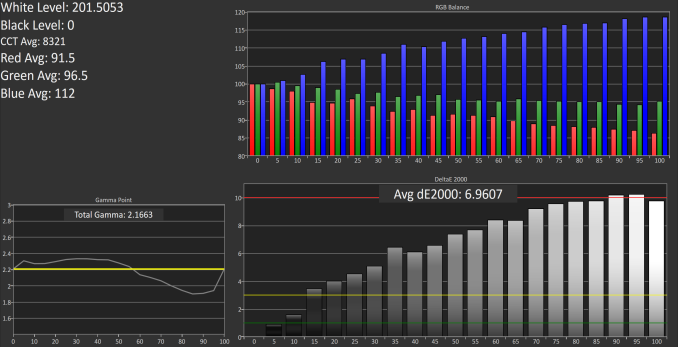

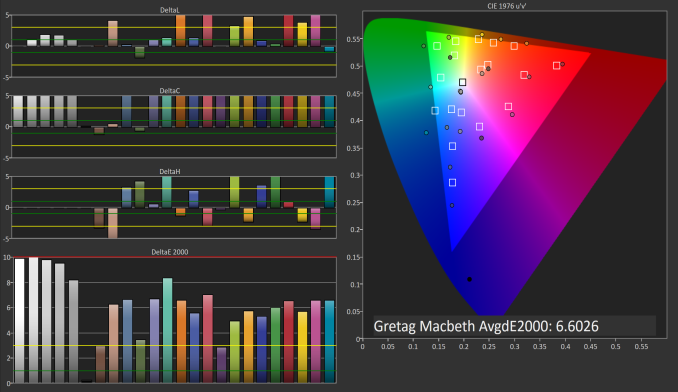








176 Comments
View All Comments
Ian Cutress - Monday, June 20, 2016 - link
We did some in the past, when Audio Precision let us borrow the $50k+ kit needed to do some proper testing. However, AP wanted the hardware back and Chris is no longer at AnandTech. If someone can convince AP to long-term loan us the hardware, I'm sure one of our smartphone team would pick up the mantle for the devices they test (and because the team is four people, it would only be tested on 1/4 of devices unless we get duplicates or can hand some off when people travel internationally for events. It also means you'd be lucky to see release day data, and we might have to do audio focused testing. But that all depends if we can get the hardware.)http://www.anandtech.com/show/8078/smartphone-audi...
dishayu - Monday, June 20, 2016 - link
Thanks for the response. Yeah, sounds like a challenge and a half. I am aware of the past audio testing, which is why I was hoping for more. Maybe a more practical approach would be to send one person to a partnered lab and run a gauntlet test on all phones released in that year... like a shootout, maybe.cheinonen - Tuesday, June 21, 2016 - link
Yeah, I'm no longer here but the equipment made to do that level of audio testing is incredibly expensive. I live down the street from Audio Precision so I could borrow it, but most people testing audio quality are using gear with noise levels that are high enough that you can't trust the testing unfortunately.Spectrophobic - Monday, June 20, 2016 - link
That... is one disgusting screen.Google please refresh the 5X with an 820 and UFS 2.0.
tipoo - Monday, June 20, 2016 - link
So provide 6GB RAM, then make the software aggressively cull its use to save energy?Apart from future proofing (and to be real, it'll probably run out of Android updates well before 3/4GB would be a limit), that seems rather pointless.
I'd hope like the author hopes that an over the air update would address that, but if the founder said it was to save energy, maybe it's just an intentional choice they'll keep around until 6GB makes any sort of sense in a phone (which again, is probably outside of the usable life of this one).
That said, I think they're generally back on track which is nice. The Oneplus One was a hit, the Two was a miss, this seems closer to the One competitively.
tipoo - Monday, June 20, 2016 - link
So 10 months after launch, much closer to the launch of the 7 now than the 6S, the NVMe storage solution is still pooping all over everyone elses, huh? The OP3 is the closest to bridging the gap on reads, but still a whole 128MB/s behind, and much further in writes (which are cool particularly for app installs - I barely see the install icon anymore after the download).I'm curious, is it *because* of NVMe? It doesn't seem like it should be, I mean NVMe is awesome but mainly reduces the AHCI latencies and gives a stupid amount of in flight queues that consumers probably don't approach often. Is it just how many channels Apple gives their NAND? Is there a limit to how much UFS 2.0 can scale up?
All this said, on the flip side, NVMe seems to take a hit in 4KB random reads/writes, with Samsungs controller overtaking the 6S there, among some others.
tipoo - Monday, June 20, 2016 - link
Hm, I see the author also suggests it's because the 6S was the 128GB model. I guess I had assumed they'd all perform the same, despite always knowing larger SSDs usually do better due to more channels.Now I want to test a 16GB 6S to see how the storage fares. What test is used?
Pissedoffyouth - Monday, June 20, 2016 - link
Random read and write matters much more than sequential, expect for heavy burst photography which the 6GB RAM should help withtipoo - Monday, June 20, 2016 - link
I recall some of the early generations of SSDs had 4K random read/write performance as a culprit for why they would freeze up for a second in worst case situations on a PC, and increasing the random performance was found to be an important metric back then as much as if not more than sequential transfers.However I do wonder at what point of 4K random read/write performance increases is where it will no longer provide any extra kick to most consumer workloads, while hopefully the OS is writing app binaries in nice sequential rows for app launch reads. Going down to 4KB reads would still very much be a very worst case scenario.
thek - Monday, June 20, 2016 - link
I feel like the reviewer reviewed this device as on-par with other premium/flagship devices that literally cost twice as much and not take into account the device's cost. And I'm not talking about just mentioning the cost itself here.The question should be if devices that cost less(and we're really talking about 1/2 the price of any flagship, with literally the same hardware) should be reviewed differently. Now, by differently I don't mean with different or lower standards ,but maybe with the knowledge that this device is clearly cheaper than other flagships devices for a reason. Something had to be cut back.
If the display was premium as well, that device wouldn't been able to get to a 399$ price mark and make a profit (only makes sense). So if it's not reaaally crucial I'd say it's a slight issue but not one to make you not purchase the phone.
Basically I'm just saying all of this because the last 3 paragraphs really dished the device into making it seem like a no-buy right now to anyone that doesn't want to suffer from a really bad display (again, this is how it sounds to a non-technical guy that just wants a smartphone). Furthermore, as you mentioned, you are a pro reviewer and have different standards, that maybe do not imply to regular users? Yes, you've mentioned it(very slightly), but saying something like you won't replace your old low end phone for this one just because of the display makes it sound probably worse than it is(or actually, the worse it can be: ''but for anyone who cares even the slightest bit the issues with the OnePlus 3’s display will be too severe to live with.''). I'd recommend providing the device for some day to day users/family members and asking if they enjoy the display.
With all of that said, I think that companies that are trying to do things differently for the better or to be cheap on the consumers expense (like Samsung, Apple, and basically any other that charges double the amount for the same hardware or charges premium prices every year for the same old battery's and storage- which Xiaomi showed us with the Redmi note 3 pro that a 4000 battery is possible with a 200$ or less phone) should be praised.
Only god knows why reviewers provide each year an A grade score for the Galaxy's and Iphone's when they don't even provide bigger batteries which is clearly out of making us buy their next phones again next year.
I'd bash them, and not OP or Xiaomi for trying to provide more for less. just my 2 cents